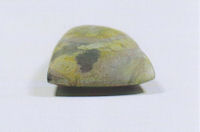
Figure 3: Coloane adze 33 (reverse)

Figure 4: Coloane adze 33 (profile)

Figure 5: Coloane adze 33 (reverse profile)

Figure 6: Coloane adze 33 (section)
The results of an initial macroscopic examination of archaeological stone from the Macau Museum Collection and the Hac Sa (1997) excavation are set out in Table 1 and Table 2. The more important artefacts are marked *.
| No. | Museum catalogue number | Implement type | Macroscopic description | Comments |
|---|---|---|---|---|
| 1* | 95HST 1 (Fig. 1) | Stone ring grinding tool | Iron-stained quartzite? | Lemon-shaped with nipples at each end, one with highly polished rim, coloured green; |
| 2* | 95HST6 (Fig. 8) | Ground unpolished adze | Coarse grained porphyritic chloritic andesitic tuff | Pale green colour; altered plagioclase phenocrysts with alteration rims; patches of oxidised iron mineral (limonite?); possible sub-angular volcaniclastic clasts; banding but no cleavage; work-worn butt; facetted sides. |
| 3* | 95HST7 302.10 | Adze | Hydrothermally altered granular quartz with sericite | Produced by the hydrothermal alteration of feldspar in the host granite. Flaked; tough texture; fractured during manufacture and discarded. |
| 4 | 95HST9A | Possibly a preform cutting tool or ring blank | Hydrothermally altered vein quartz with sericite | Cryptocrystalline texture; iron-stained along fractures; one side is flat and other side is rounded. Struck pebble. |
| 5 | 95HST15 | Struck flake | Massive strained quartz | Bulb of percussion and step-fractures; superficial iron staining; not utilised as a tool. |
| 6 | 95HST16 | Struck flake | Massive quartz | Lacks bulb of percussion, sharp edges, unworked. |
| 7 | 95H5T17 | Struck pebble | Strained cryptocrystalline quartz | Brittle, tabular fracture, |
| 8 | 95HST18 | Preform cutting tool or ring blank | Quartz | Flakes detached from pebble to form cutting edge |
| 9 | 95HST23 | Preform cutting tool or ring blank | Quartz | Ground curved cutting edge; transverse fracture; brittle. |
| 10 | 95HST25 | Struck flake | Massive quartz | Sharp edges, unworked, iron stained. |
| 11 | 95HST26 | Possible preform tool or ring blank | Vein quartz with secondary mineral inclusions | Pecked to form curved blade-like profile but transverse fracture presumably occurred during shaping process. Modified pebble, |
| 12 | 95HST28 | Struck flake | Vein quartz | Chip detached from cobble |
| 13 | 95HST40 | Unworked pebble | Strained massive quartz | Iron-stained, natural tabulate fracture |
| 14* | 95HST56304.1 | Not a tool | Coarse-grained porphyritic chloritic tuff | Iron-stained; differentially weathered; green coloured groundmass; angular and sub-angular fracture; siliceous/feldspathic inclusions; |
| 15* | 95HST61 | Modified pebble | Micaceous bedded metasediment | Fine grained; green coloured; flaked parallel to strong cleavage; dark spotting micaceous; small corroded patches and intergrowths of pale-coloured altered feldspar; (naturally?) rounded end |
| 16 | 95HST90 | Possibly preform ring blank | Recrystallised cryptocrystalline quartz | Iron-stained, modified edge, bi-convex with flat edge, partly polished on both sides. |
| 17* | 95HST94 | Failed preform tool? | Altered quartz with secondary muscovite and chlorite | Relict slikensliding producing stepped fracture; failed along mineralised veinlet; rounded pecked unground edge |
The following discussion points arise from the information presented in Tables 1 and 2.

Figure 3: Coloane adze 33 (reverse)

Figure 4: Coloane adze 33 (profile)

Figure 5: Coloane adze 33 (reverse profile)

Figure 6: Coloane adze 33 (section)
The makers of prehistoric stone rings were very selective in their choice of raw material. They seemed to prefer vein quartz, which had either been altered chemically by hydrothermal mineralisation and/or strained by tectonic action. Considering the occurrence of altered quartz excavated from the Hac Sa site:
A microscopic examination of the rocks in polished thin section is necessary to confirm, or otherwise, the macroscopic descriptions provided in the Tables 1 and 2. Two categories of archaeological stone are represented in the examined material: mineral and stone. The mineral material was substantially quartz; the type of utilised stone material was more variable.
Stone tool No. 33 (Figures 2-7) was examined in addition to the items reported in Tables 1 and 2. This adze, which was donated by the finder to the Macau Museum but is not currently displayed, was a chance find in the area adjacent to the Hac Sa (South) excavation site. It is a good-quality ground and polished adze. Visually, the petrology of some adzes from Hong Kong, for example, adze No. 86 (Lo So Shang site 97), and adze No. 81 (Hai Dei Wan site 39), closely resemble this implement. Macroscopically, the rock is volcaniclastic, similar to a welded tuff.
© Internet Archaeology/Author(s) URL: http://intarch.ac.uk/journal/issue26/7/4.html
Last updated: Wed Jun 10 2009